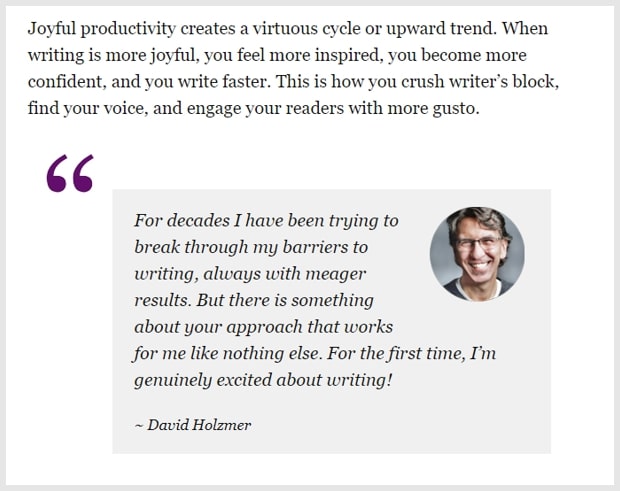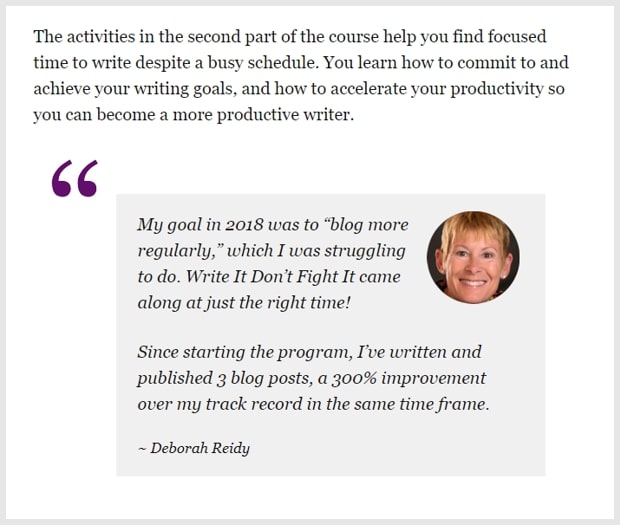
T estimonials are powerful marketing tools. They add credibility and boost your persuasiveness. They help sell your products and services—but only if they’re not overly sugary.
This article discusses:

As legendary copywriter David Ogilvy wrote:
You should always include testimonials in your copy. The reader finds it easier to believe the endorsement of a fellow consumer than the puffery of an anonymous copywriter.
Ogilvy wrote those words in his book Confessions of an Advertising Man, originally published in 1963.
Yet, over 5 decades later, testimonials are still one of the most underused sales tactics online.
That’s because most testimonials are overly sugary so they’re ineffective.
Plus, testimonials are often hidden away on a website; they’re not placed where they matter most and where web visitors will see them.
This article provides a mini-course on using testimonials to add credibility and boost your persuasiveness so you can sell more.
I’m sure you’ve read ineffective testimonials like this:
These testimonials are far too sugary to be believable. They don’t help to sell because they don’t give readers a specific reason why a service or product was so good.
Powerful testimonial are more like miniature stories, sharing the experience of a service or product and giving reasons why other should consider buying, too.
A testimonial is a statement from a customer explaining how much they enjoyed a product or service.
To make a testimonial effective, pay attention to these 4 elements:
A good testimonial explains how specifically a product or service improved someone’s life. It does so in an authentic way.
Shall I show you how?
Here’s an example of how Blazen Web Marketing transformed a business:
Their work on our website and Internet marketing has made a significant different to our business. We’ve seen a 425% increase in quote requests from the website which has been pretty remarkable – but I’d always like to see more!
Why does this testimonial work?
The following example is a testimonial for Case Study Buddy :
Writing case studies was a daunting task for us. We didn’t know where to begin or what questions to ask, and clients never seemed to follow through when we asked.
Case Study Buddy did everything – with almost no time or effort for me! The best part was that I could completely trust their team to represent our company professionally with our clients.
Why does this testimonial work?
The following example is a testimonial for sales email experts Salesfolk :
As a sales gamification company, we were skeptical to work with a consultant to optimize our sales emails, but Salesfolk was highly recommended by many other Y-Combinator startups we knew. Salesfolk helped us run a ~6 week email campaign that brought us more leads than we had ever seen for a single effort.
Why does this testimonial work?
A good testimonial always feels real and authentic. It gives specific details, and either demonstrates a benefit or takes away an objection.
Below follow two simple templates to help you write a testimonial faster:
The reason this testimonial template works so well is that people don’t buy a product. They buy a better life. And this type of testimonial demonstrates how someone’s life was improved.
The template follows a 3-part structure:
I bought this course because I have struggled to make my own website for my solo language coaching business for 8 years. I got stuck on the copy every single time.
I wanted to learn how to persuade potential clients to get in touch with me because selling my service in a foreign language market is extremely difficult. Henneke’s course saved me. I loved the recipes that teach you, step by step, how to organize your sales page and what to say in each section. Each section has an objective. Plus, the example layouts for different kinds of businesses were invaluable.
I sailed through the course in about 10 days because it’s sectioned into digestible modules that kept me curious to learn more. My copywriting skills have improved drastically and I’ve taken up a new interest in the world of copywriting. Thank you, Henneke!
~ Alanna Beach, online language coach
You can see the 3-part structure in action:
Below follows another example using the same testimonial template. This testimonial is for the Enchanting Blog Writing course:
I’ve done a couple of writing courses in the past and I have loads of ideas. But I get overwhelmed and I’m not good at structuring my writing. So I still felt stuck.
After reading Henneke’s blog for a few months, I purchased the Enchanting Blog Writing course because I like the way her blog posts read and because I hoped the course would give me some direction and motivation to sort out my blog.
Henneke’s teaching is simple, yet detailed, and I love the huge number of examples in this course. I had not realized how powerful examples are. The examples help teach what Henneke calls X-ray reading so I can now see how others write their blog posts, and I’m starting to create my own blogging voice.
Many courses promise to give step-by-step guidance but still leave you wondering what to do next. Henneke’s course is different.
At the end of the course, I knew what to do. I’ve just created my first post of over 3,000 words, and it didn’t feel like a daunting task. I know what to write in the opening. I know what to write in the closing paragraph, and I know what to put in the sections in between.
Thank you, Henneke. I’m super-grateful for this course.
~ Dylan Ball, Vocal Coach
The 3-part structure is a little expanded in this version:
Have you noticed how real these testimonials feel?
They’re like miniature stories that give an impression of someone’s transformation—from being stuck to writing with ease.
If you need to write a testimonial, you can do the same. Describe the situation before you purchased, explain your experience of a service, and then share what the result has been.
No need to be overly positive. Share specific details. And keep it real.
This second template explains a hesitation to buy or to hire someone, and why this hesitation was misplaced.
This template works well as a selling tool because if you’ve hesitated to buy, there’ll be others who hesitated for the same reason. By showing why you went ahead and why you’re glad you did, you help take away that same objection with others.
The template works as follows:
I was unsure if the Enchanting Copywriting course would apply to my small e-commerce store; I thought it might be more suitable for higher-priced offerings like an e-course or coaching sessions. I also own both of Henneke’s copywriting books and was afraid there would be some overlap.
But my product descriptions were sprawling all over the place and I needed a better understanding of the structure of persuasive sales copy, so I took the leap and I’m glad I did.
Henneke doesn’t only teach you how to write a sales page, you learn so much more. For example, the psychology behind why your customer buys your product and methods of how to guide them if they’re hesitating.
This course is incredibly well structured and to the point. Henneke teaches complicated concepts in a simple way and helps you sail through the course pain-free. The watch-listen-write “triple punch” format of the Enchanting Copywriting course doesn’t only work for different learning styles but together they’re a powerful means to make you actually learn. I could feel my brain growing while doing the activities. I would gladly buy this course again just for the teaching style alone. I’ve taken many online courses but I don’t think I’ve ever learned so much in an online course as in this one.
Many of the techniques I’ve learned I now use in other writing as well, like my blog articles and in my emails. My writing is much clearer and I have a system to follow so my sales copy is more concise and straightforward.
~ Susanna Tham
You can see the 4-part structure in action:
You can see the same structure in action in this testimonial for the same copywriting course:
I’ve bought so many digital courses and had to practice sheer discipline to finish them, and even so I end up dropping the ball and the course lands in an unknown digital drawer.
This course is different.
Henneke has broken down the teaching in a logical way to help you stay on track. After each module, I am wondering what she’ll be tackling in the next and want to step on the gas pedal!
This course teaches you much more than writing persuasive sales pages. Right from module one I started to incorporate Henneke’s teachings into everything I wrote. Without much effort my communication (so not only what I wrote, but also how I brought ideas forward) became clearer, more to the point and hence a lot more effective.
Even if you do not write a page but you outsource it, this course will give you everything you need to write a draft, brief the copywriter and assess the work.
~ Claudia Schalkx
How this testimonial works:
A good testimonial is like a miniature story, describing how one person’s life improved after taken a course, hiring a coach or consultant, taking part in a workshop, etc.
Others who can recognize themselves in these stories. They may be hesitating to purchase for the same reasons. Or they find themselves in the same situation—such as feeling stuck writing—and dream of a similar transformation taking place—such as making their writing clearer and the process of writing easier.
But if you’re a service provider, course seller, consultant, or coach, how do you get such powerful testimonials?
If you simply ask clients for a testimonial, it’s unlikely the testimonial will be as effective as the examples discussed in this article.
To get a powerful testimonial, ask your client for input and write the testimonial yourself. To get the right input, ask your client:
Below follows an example of a testimonial request for my blog writing course. In this case, someone had already mentioned they’d be happy to write a testimonial:
Are you still happy to help with a testimonial for the course?
If you like, please answer the questions below, and I’ll compose the testimonial based on your answers. Of course, I’ll send it to you for approval:
Of course, no hurry. But it’d be lovely to get my first review from you 🙂
As you can see, question #1 relates to the before-situation. I asked question #2 because it gave me the option to write a testimonial based on the objection-busting template (template #2 above). Question #3 and #4 are about the experience of the course. By asking two questions about the experience, I increase the chance of getting some specific input. And the last question is to get an idea of what the post-course experience is like.
You may find that a client gives brief answers without any specifics. If that happens, go back and ask them whether they can explain what exactly they meant or whether they can give an example of how exactly their writing skills improved.
I adapt the email to request a testimonial almost every time. If I have a specific reason to ask a review, then I’ll mention that in the email. For instance: I’d love to get a review from you because you work in the charity sector, and I don’t have a review from this sector yet.
And if I know that someone hesitated for a specific reason, I’ll mention that in the email, too. For instance: I remember you were hesitant to buy the course because you thought the price was high. I’d love to hear what your experience has been.
Lastly, if it feels too awkward to ask for a testimonial, I may simply phrase the email (with similar questions) as a request for feedback.
How to write up a testimonial on behalf of a client:
Of course, when you’ve written the testimonial, be sure to check your client is happy with how it turned out before publishing it.
To get good testimonials, make it easy for your client. And do most of the work yourself.
Too many websites hide their testimonials on a dedicated page that rarely gets visited.
But testimonials have more power, if you use them as proof that your product or service is good. Use them as a selling tool wherever you sell your products or services:
Testimonials have most power if they confirm what’s written in your copy.
For instance, on the sales page for the Write It, Don’t Fight It course, I explain that the course teaches the principles of joyful productivity so you can crush writer’s block, and I follow it with a testimonial of David Holmzer confirming this point.
David explains how he’s struggled for decades with writing but since taking the course, he feels finally excited to write:

And later on on the same sales page, the text mentions how the course helps you to hit your writing goals even if you’re busy, and a testimonial from Deborah Reidy follows to confirm this point.
Deborah explains how the course helped her boost productivity by 300%:

Testimonials look more persuasive if you add a picture of the person who’s given the testimonial. I often download a photo from a social media profile but always ask permission whether it’s okay to do that.
The more work you put into getting the right testimonials, the harder the testimonials will work for you and the more you will sell.
Asking for testimonials seems hard.
I’ve been there, too. Why bother a client with such a request?
But I was wrong.
Most clients are delighted to help you with a testimonial.
So, next time you finish a project, ask your client whether they’re happy with your services and whether they’d recommend you to other people.
Do they say “yes?”
Ka-ching! This is your opportunity to get a persuasive testimonial. And win more clients.